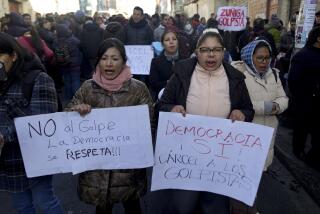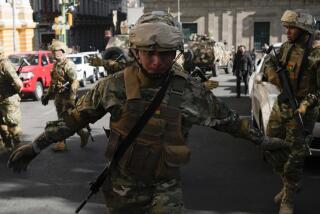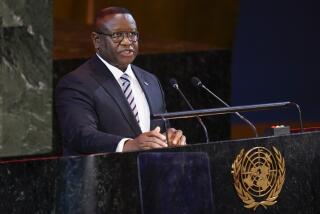Philippine Jets Strafe Rebel Posts as Fight Resumes in Manila : Civil War: President Corazon Aquino tells rebel troops to ‘surrender or die’ and says there will be no negotiation with leaders of the latest attempt to overthrow her government.
- Share via
MANILA — Philippine jets and helicopters on Saturday blasted suspected military rebels battling President Corazon Aquino’s forces for a second day in the strongest bid yet to topple her administration.
Aquino told rebel soldiers Saturday to “surrender or die,” saying there would be no negotiation with leaders of the abortive attempt to overthrow her.
She accused leaders of the political opposition in the Philippines of financing and backing the coup and vowed to “root out those who have given aid and comfort to these traitors.”
In a toughly worded statement, Aquino said her troops would continue their present offensive “until the last trace of resistance is removed. We shall not entertain any offer to negotiate,” she declared.
“We leave them with two choices : to surrender or die,” Aquino said. “I advise them to choose wisely,” she added during a press conference at her Malacanang palace.
She said the coup attempt by rebel Marine and army units had set back the country of 60 million people both politically and economically.
In one attack, air force F-5s strafed loyal soldiers by mistake, killing at least six of them and wounding 20 near armed forces headquarters at Camp Aguinaldo.
The military meanwhile announced the arrest of one of the coup leaders, Lt. Col. Tito Legazpi, as he was en route Saturday to Bataan to recruit followers for further attacks against the government.
Brig. Gen. Oscar Florendo said Legazpi took part in Friday’s assault on the Sangley Point naval air station, one of the garrisons seized by the mutineers in the sixth attempt to oust Aquino since she came to power 3 1/2 years ago.
In clashes Friday, 22 people were killed and 87 wounded when mutineers seized military facilities and two broadcasting stations.
Renewed fighting Saturday continues the most serious coup attempt since Aquino took office in February, 1986, after a popular uprising drove the late President Ferdinand E. Marcos into exile in Hawaii.
Military and civilian officials expressed confidence that they would finish off the rebels by day’s end. Brig. Gen. Rodolfo Biazon, chief of the National Capital Region Defense Command, estimated that no more than 300 rebels remained in the capital.
“Hopefully within the day we will finish them off,” Biazon said.
Elfren Cruz, chairman of the Metro Manila Commission, described Saturday’s fighting as mopping up and predicted the capital would return to normal by Monday.
Estimates of rebel strength at the high point of the insurrection ranged from 800 to 2,000, the Associated Press reported.
In Washington, Rear Adm. Edward Sheafer told a news conference that U.S. officials were “cautiously optimistic” the coup would fail, United Press International reported.
President Bush was monitoring the situation from Malta, site of his meeting with Soviet leader Mikhail Gorbachev. On his flight to Malta, Bush, saying, “We’re doing what has been requested of us,” authorized U.S. fighter planes to help Aquino’s forces.
National security adviser Brent Scowcroft said in Malta, “President Aquino feels her situation is improving. However, it must be said the coup attempt was still in progress.”
Fighting on Saturday took place in neighborhoods near Camp Aguinaldo, where rebel soldiers deployed late Friday after abandoning government television and Villamor Air Base.
After sunrise Saturday, three helicopters began firing at troops but it was unclear whether all were on the same side. It appeared at least one helicopter was from the government side and was firing at the rebels.
About 7 a.m. (3 p.m. PST Friday) two F-5s swooped down on suspected rebels, blasting them with .50-caliber machine-gun fire. But their targets turned out to be about 2,000 loyal soldiers sent to Manila area from central and southern Luzon to crush the coup attempt.
Brig. Gen. Thelmo Cunanan, commanding the government force, said six of his men were killed and 20 wounded.
“We thought the planes were friendly but they fired at us,” Cunanan said. “We were told later it was a case of mistaken identity.”
Cunanan said nine jeeps and one ammunition truck were destroyed.
Defense Secretary Fidel Ramos said the mistake “is one of those things that happen in a situation like this.” He said damage would be worse if rebels were allowed to roam free.
Later Saturday, helicopter gunships resumed the attacks near Camp Aguinaldo, but casualties were not known. Witnesses reported fires in the area after the strafing.
Brig. Gen. Oscar Florendo, chief of the civil relations service, urged civilians in the densely populated area to stay indoors until order is restored.
Manila radio stations had identified the attacking jets on Saturday as American, but U.S. and Philippine officials denied that. On Friday, U.S. F-4 jets flew air cover for government forces, but the U.S. Embassy said American flights ended at 6 a.m. Saturday (2 p.m. PST Friday).
The mutineers appeared to include both marines and army men. Pro-government ground troops came from Philippine Constabulary units rushed into the capital Friday from central and southern Luzon districts.
U.S. Air Force F-4s from Clark Air Base, 50 miles north of Manila, roared over the city Friday, halting rebel air attacks after rebel planes and helicopters raided the presidential palace, military camps and a TV station earlier in the day.
Mutineers withdrew from government television and Villamor late Friday after U.S. jets flew air cover.
But the rebels marched with armored vehicles through the night toward Camp Aguinaldo, their ranks swelled by marines from Ft. Bonifacio.
The U.S. air action enabled the government to consolidate its forces and block rebels from moving against the palace and other points in the capital.
A senior U.S. official said in Washington that it appeared 300 rebels were confronting about 2,000 troops Saturday near a major intersection, but there was some expectation of a negotiated settlement to avoid bloodshed.
He said Aquino was in the presidential palace and “very well protected.”
Gen. Renato de Villa, military chief of staff, said the sixth coup attempt against Aquino had failed. Manila radio stations broadcast a statement from her Friday night saying the “enemy is routed, but is not yet vanquished.”
None of the mutinous soldiers questioned would say who directed the revolt. Rebel sources said the leaders included renegade Lt. Col. Gregorio (Gringo) Honasan, who headed an August, 1987, coup attempt in which at least 53 people were killed.
Honasan has been at large since his escape from prison in April, 1988.
One hundred U.S. Marines were sent from an American base to help protect the U.S. Embassy.
Pentagon spokesman Pete Williams said no U.S. planes “fired any shots or intercepted any rebel aircraft.”
“President Aquino’s request was very specific . . . to conduct an aggressive cap over two Philippine air bases, Villamor and Sangley Point,” the Administration official said, on condition of anonymity.
A spokesman for the rebels said the U.S. move was an affront to Filipino sovereignty and the mutineers would hold Ambassador Nicholas Platt personally responsible for the intervention.
About 40,000 U.S. military personnel, dependents and Defense Department civilians are stationed at six bases in the Philippines. Orders were issued restricting their travel and Americans were told to stay in their homes.
In addition to those assigned to the bases, up to 100,000 Americans live in the Philippines, according to the embassy.
Most of the mutineers appeared to be from the army and marines, considered the best of the archipelago’s 160,000-member armed forces.
During the August, 1987, coup attempt, civilians poured into the streets to support Aquino and cheer government forces. But this time, people watched in silence.
Public discontent with the Aquino government has grown because of rising prices, an electricity shortage and allegations of corruption among her relatives and supporters.
More to Read
Sign up for Essential California
The most important California stories and recommendations in your inbox every morning.
You may occasionally receive promotional content from the Los Angeles Times.













